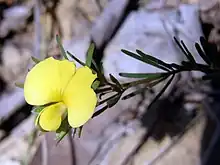Gompholobium glabratum
Gompholobium glabratum, commonly known as dainty wedge-pea,[2] is a species of flowering plant in the family Fabaceae and is endemic to south-eastern continental Australia. It is a low-lying or ascending shrub with pinnate leaves that have five to seven leaflets, and yellow and green or greyish flowers.
| Dainty wedge-pea | |
|---|---|
 | |
| Gompholobium glabratum at Ku-ring-gai Chase National Park, Australia | |
| Scientific classification | |
| Kingdom: | Plantae |
| Clade: | Tracheophytes |
| Clade: | Angiosperms |
| Clade: | Eudicots |
| Clade: | Rosids |
| Order: | Fabales |
| Family: | Fabaceae |
| Subfamily: | Faboideae |
| Genus: | Gompholobium |
| Species: | G. glabratum |
| Binomial name | |
| Gompholobium glabratum | |
| Synonyms[1] | |
|
Gompholobium polymorphum Benth. nom. inval., pro syn. | |
Description
Gompholobium glabratum is a low-lying or ascending shrub that typically grows up to a height of 5–40 cm (2.0–15.7 in) and has pimply stems. The leaves are pinnate with five to seven leaflets that are linear to narrow lance-shaped, 10–15 mm (0.39–0.59 in) long and 0.5–1.5 mm (0.020–0.059 in) wide and more or less glabrous, the edges curved down or rolled under. The flowers are arranged in small groups on the ends of branchlets, each flower on a pedicel 4–10 mm (0.16–0.39 in) long with sepals up to about 8 mm (0.31 in) long. The petals are 8–10 mm (0.31–0.39 in) long, the standard petal and wings yellow or greenish-yellow and the keel dark brown to greyish. Flowering occurs from August to October and the fruit is an oval pod 8–10 mm (0.31–0.39 in) long.[2][3]
Taxonomy and naming
Gompholobium glabratum was first formally described in 1825 by Augustin Pyramus de Candolle in his Prodromus Systematis Naturalis Regni Vegetabilis.[4][5] The specific epithet (glabratum) means "nearly glabrous".[6]
Distribution and habitat
Dainty wedge-pea grows forest and heath on the coast and tablelands of New South Wales south from Forster to the far north-eastern corner of Victoria.[2][3]
References
- "Gompholobium glabratum". Australian Plant Census. Retrieved 6 August 2021.
- Jeanes, Jeff A. "Gompholobium glabratum". Royal Botanic Gardens Victoria. Retrieved 6 August 2021.
- Wiecek, Barbara. "Gompholobium glabratum". Royal Botanic Garden Sydney. Retrieved 6 August 2021.
- "Pultenaea glabratum". APNI. Retrieved 6 August 2021.
- de Candolle, Augustin P. (1825). Prodromus Systematis Naturalis Regni Vegetabilis. Vol. 2. Paris. p. 106. Retrieved 6 August 2021.
- Sharr, Francis Aubi; George, Alex (2019). Western Australian Plant Names and Their Meanings (3rd ed.). Kardinya, WA: Four Gables Press. p. 206. ISBN 9780958034180.